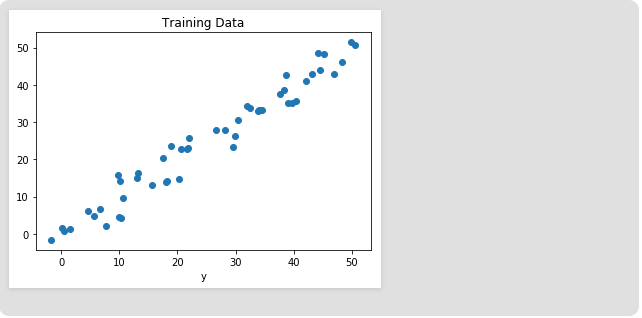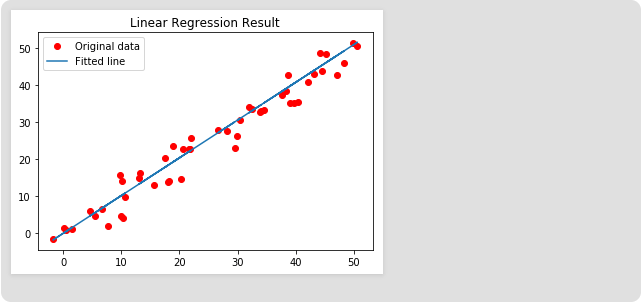Linear Regression in TensorFlow
Linear Regression is a machine learning algorithm that is based on supervised learning. It performs a regression function. The regression models a target predictive value based on the independent variable. It is mostly used to detect the relation between variables and forecasts.
Linear regression is a linear model; for example, a model that assumes a linear relationship between an input variable (x) and a single output variable (y). In particular, y can be calculated by a linear combination of input variables (x).
Linear regression is a prevalent statistical method that allows us to learn a function or relation from a set of continuous data. For example, we are given some data point of x and the corresponding, and we need to know the relationship between them, which is called the hypothesis.
In the case of linear regression, the hypothesis is a straight line, that is,
h (x) = wx + b
Where w is a vector called weight, and b is a scalar called Bias. Weight and bias are called parameters of the model.
We need to estimate the value of w and b from the set of data such that the resultant hypothesis produces at least cost ‘j,’ which has been defined by the below cost function. 
Where m is the data points in the particular dataset.
This cost function is called the Mean Squared Error.
For optimization of parameters for which the value of j is minimal, we will use a commonly used optimizer algorithm, called gradient descent. The following is pseudocode for gradient descent:
Where ? is a hyperparameter which called the learning rate.
Implementation of Linear Regression
We will start to import the necessary libraries in Tensorflow. We will use Numpy with Tensorflow for computation and Matplotlib for plotting purposes.
First, we have to import packages:
To make the random numbers predicted, we have to define fixed seeds for both Tensorflow and Numpy.
Now, we have to generate some random data for training the Linear Regression Model.
Let us visualize the training data.
# Plot of Training Data
Output

Now, we will start building our model by defining placeholders x and y, so that we feed the training examples x and y into the optimizer while the training process.
Now, we can declare two trainable TensorFlow variables for the bias and Weights initializing them randomly using the method:
Now we define the hyperparameter of the model, the learning rate and the number of Epochs.
Now, we will build Hypothesis, Cost Function and Optimizer. We will not manually implement the Gradient Decent Optimizer because it is built inside TensorFlow. After that, we will initialize the variables in the method.
Now we start the training process inside the TensorFlow Session.
Output is given below:
Epoch: 50 cost = 5.8868037 W = 0.9951241 b = 1.2381057 Epoch: 100 cost = 5.7912708 W = 0.9981236 b = 1.0914398 Epoch: 150 cost = 5.7119676 W = 1.0008028 b = 0.96044315 Epoch: 200 cost = 5.6459414 W = 1.0031956 b = 0.8434396 Epoch: 250 cost = 5.590798 W = 1.0053328 b = 0.7389358 Epoch: 300 cost = 5.544609 W = 1.007242 b = 0.6455922 Epoch: 350 cost = 5.5057884 W = 1.008947 b = 0.56223 Epoch: 400 cost = 5.473068 W = 1.01047 b = 0.46775345 Epoch: 450 cost = 5.453845 W = 1.0118302 b = 0.42124168 Epoch: 500 cost = 5.421907 W = 1.0130452 b = 0.36183489 Epoch: 550 cost = 5.4019218 W = 1.0141305 b = 0.30877414 Epoch: 600 cost = 5.3848578 W = 1.0150996 b = 0.26138115 Epoch: 650 cost = 5.370247 W = 1.0159653 b = 0.21905092 Epoch: 700 cost = 5.3576995 W = 1.0167387 b = 0.18124212 Epoch: 750 cost = 5.3468934 W = 1.0174294 b = 0.14747245 Epoch: 800 cost = 5.3375574 W = 1.0180461 b = 0.11730932 Epoch: 850 cost = 5.3294765 W = 1.0185971 b = 0.090368526 Epoch: 900 cost = 5.322459 W = 1.0190894 b = 0.0663058 Epoch: 950 cost = 5.3163588 W = 1.0195289 b = 0.044813324 Epoch: 1000 cost = 5.3110332 W = 1.0199218 b = 0.02561669
Now, see the result.
Output
Training cost= 5.3110332 Weight= 1.0199214 bias=0.02561663
Note that in this case, both weight and bias are scalars in order. This is because we have examined only one dependent variable in our training data. If there are m dependent variables in our training dataset, the weight will be a one-dimensional vector while Bias will be a scalar.
Finally, we will plotting our result:
Output

